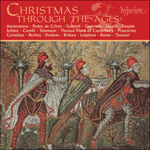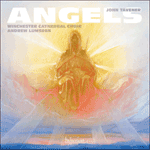Very different in character are the Christmas pieces
Today the Virgin (1989) and
God is with us. The latter is described as a ‘Christmas proclamation’, and was completed in 1987 for Martin Neary and the Choir of Winchester Cathedral. The text is adapted from the Orthodox service of Great Compline, which is sung on Christmas Eve; its basis is biblical. Beginning in tranquillity, the piece is in fact a radiant and joyful celebration. Much use is made of a solo tenor who sings a haunting melody, Byzantine in inspiration, while the choir sings cascades of notes around him. The shock comes in the final section with the introduction of the organ at the words ‘Christ is born!’, when the music is disconcertingly freed from harmonic weight.
from notes by Ivan Moody © 1991
Les ouvrages pour Noël
Today the Virgin («Aujourd’hui la Vierge»; 1989) et
God is with us («Dieu est avec nous») sont de caractère très différent. Le second, décrit comme une «Proclamation de Noël» fut terminé en 1987 pour Martin Neary et le Chœur de la Cathédrale de Winchester. Le texte est adapté du service orthodoxe de Grandes Complies, qui se chante la veille de Noël; il se base sur la Bible. Le morceau commence dans la tranquillité mais il est, en fait, une célébration joyeuse et radieuse. Une partie importante est donnée à un ténor solo qui chante une mélodie obsédante d’inspiration byzantine, tandis que le chœur chante autour de lui des cascades de notes. Le choc vient dans la section finale avec l’introduction de l’orgue avec les mots «Christ est né!», quand la musique se libère de façon déconcertante de son poids harmonique.
extrait des notes rédigées par Ivan Moody © 1991
Français: Alain Midoux
Gänzlich anders gestaltet sind die Weihnachtsstücke
Today the Virgin (1989) und
God is with us. Das zweite Stück trägt die Bezeichnung „Weihnachtsproklamation“ und wurde 1987 für Martin Neary und den Chor der Winchester Cathedral vollendet. Der Text ist dem orthodoxen Gottesdienst des großen Kompletoriums entlehnt, der am Heiligabend begangen wird; er beruht auf einem Bibeltext. Das Stück beginnt zwar ruhig, entfaltet sich jedoch zu strahlender, freudiger Feierlichkeit. Der Solotenor kommt ausgiebig zum Einsatz mit einer byzantisch inspirierten, betörenden Melodie, während der Chor ihn mit Notenkaskaden umgibt. Der Schock erfolgt im Schlußteil, wenn bei den Worten „Christ ist geboren!“ die Orgel einsetzt und die Musik auf beunruhigende Weise von harmonischem Ballast befreit wird.
aus dem Begleittext von Ivan Moody © 1991
Deutsch: Anne Steeb/Bernd Müller


 Christmas through the ages
Christmas through the ages Tavener: Angels & other choral works
Tavener: Angels & other choral works
